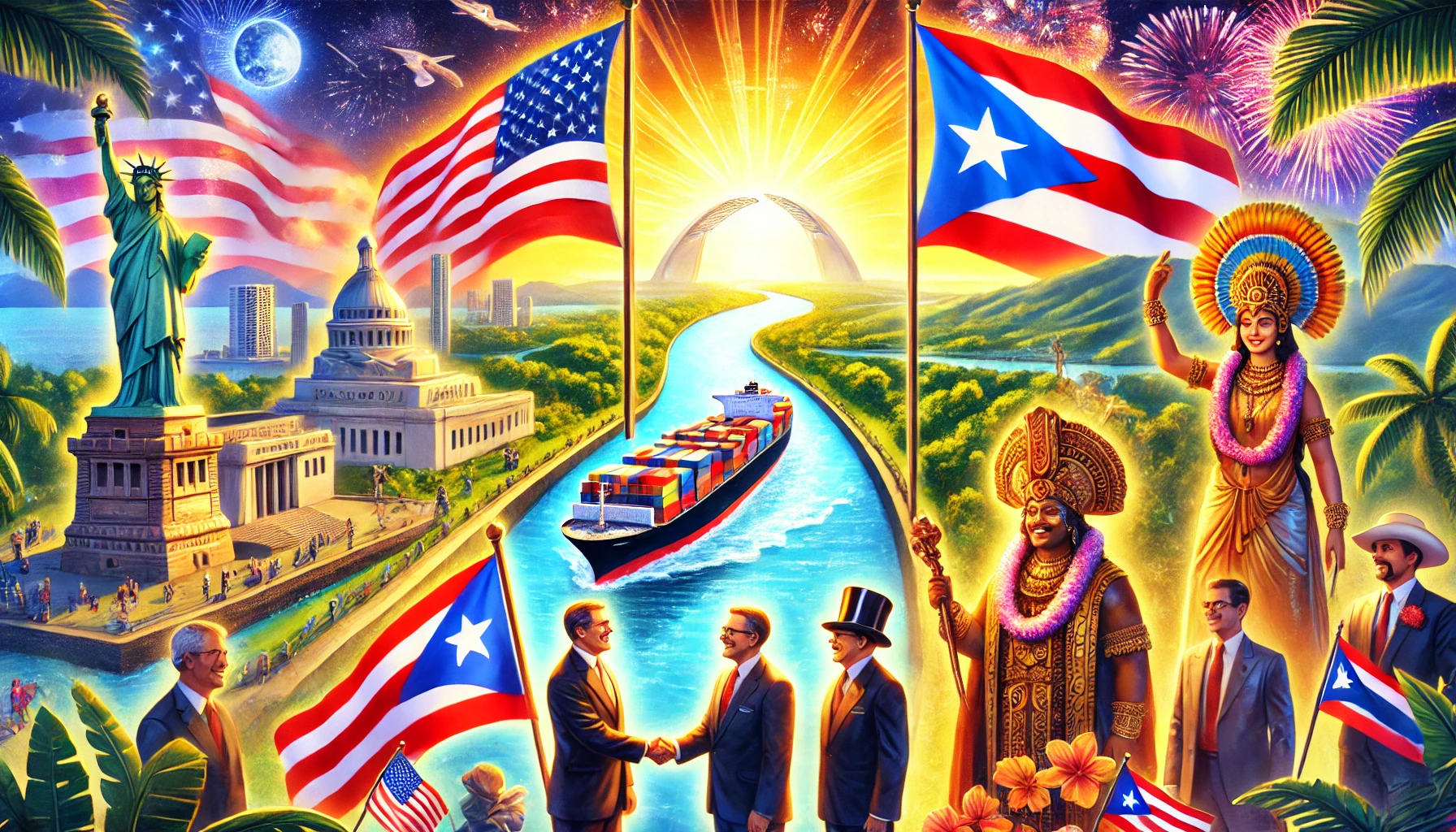The tides of history are shifting. President Donald J. Trump has vowed to correct what he calls “one of America’s greatest strategic blunders”—the giveaway of the Panama Canal. At the same time, Puerto Rico is poised to finally become the 51st state of the Union, while Hawaii is set to reclaim its sovereignty. These moves, according to Trump, will “make America greater than ever before.”
The Panama Canal, a vital artery of global commerce, was handed over to Panama in 1999 under the terms of the Torrijos-Carter Treaties. At the time, the decision was framed as a diplomatic triumph, symbolizing cooperation and trust. But Trump sees it differently. “It was a terrible mistake,” he declared at a rally in Miami. “We built it. We paid for it. And now, we’re taking it back.”
Negotiations with Panama have been swift, sources say, with Panamanian officials eyeing the economic opportunities that American reinvestment could bring. “This is a win-win,” said one senior Panamanian diplomat. “We get American jobs, American infrastructure, and America gets control over the most important canal in the world.”
The economic implications for Panama are enormous. With U.S. stewardship, the canal will likely see expanded operations, modernized logistics, and an influx of American capital. Experts predict a boom in tourism, trade, and job creation. “Panama will become the economic powerhouse of Latin America,” said former U.S. Trade Representative Robert Lighthizer. “You watch and see.”
While the canal returns to American hands, Puerto Rico is set to join the Union officially. The U.S. territory has long debated statehood, and Trump insists that now is the time. “Puerto Rico has given us their best and brightest,” he said. “Now it’s time to give them the respect they deserve. They’re Americans, and they should have full representation.”
For Puerto Ricans, the promise of statehood brings hope and opportunity. Federal funding, voting rights, and congressional representation have been long-standing demands. Polls suggest that most residents favor the move, seeing it as a chance to rebuild after devastating hurricanes and economic setbacks.
As Puerto Rico steps into its new role as America’s 51st state, Hawaii will be granted sovereignty. The island chain, annexed in 1898 and statehood granted in 1959, has long harbored a strong independence movement. Trump’s bold move to recognize Hawaii as a sovereign nation is seen as both a nod to historical grievances and a strategic repositioning. “Hawaii will always be our friend, our ally,” Trump said, “but it’s time they take control of their own destiny.”
Native Hawaiian leaders have expressed cautious optimism about the transition. “This is a step toward reclaiming our heritage,” said Keoni Souza, a Honolulu-based activist. “Our culture, our land, our identity—it’s finally in our hands.”
Trump’s vision is clear: one island nation replaces another as the 51st state, strengthening America in the process. “We are making the right moves, finally,” he said. “Puerto Rico comes in, Hawaii stands on its own, and America gets back what we never should have lost—the Panama Canal.”
Reaction to the announcements has been mixed. Supporters hail the moves as bold, necessary, and long overdue. Critics warn of geopolitical tensions, economic risks, and legal challenges. China, which has invested heavily in Latin American infrastructure, has expressed “serious concern” over the developments in Panama. Some lawmakers in Congress have also voiced skepticism, questioning the feasibility and cost of reclaiming the canal.
Yet, Trump remains undeterred. “America doesn’t apologize,” he said. “We fix mistakes, we make deals, and we always come out on top.”
As details unfold, Wall Street is watching closely. Analysts predict Puerto Rico’s entry into the Union could spur investment in its struggling economy, while the Panama Canal’s return could have ripple effects across global shipping and trade. Hawaii’s new sovereign status may open up fresh opportunities for international partnerships and cultural exchange.
For many Americans, these developments stir deep emotions. Older generations remember the Panama Canal as a point of national pride, while Puerto Ricans see statehood as a long-overdue affirmation of their identity. In Hawaii, sovereignty is viewed as a long-fought victory.
“We’re seeing history in the making,” said political analyst James Harkin. “For better or worse, these are changes that will redefine America’s place in the world.”
Whether these shifts will achieve Trump’s ambitious goals remains to be seen, but one thing is certain—the winds of change are blowing strong. The Panama Canal, Puerto Rico, and Hawaii are at the forefront of America’s evolving future, each playing a pivotal role in the nation’s next chapter.
The Hawaiian Kingdom, also known as the Kingdom of Hawaiʻi (Hawaiian: Ke Aupuni Hawaiʻi), was an archipelagic country from 1795 to 1893, which eventually encompassed all of the inhabited Hawaiian Islands. It was established in 1795 when Kamehameha I, then Aliʻi nui of Hawaii, conquered the islands of Oʻahu, Maui, Molokaʻi, and Lānaʻi, and unified them under one government. In 1810, the Hawaiian Islands were fully unified when the islands of Kauaʻi and Niʻihau voluntarily joined the Hawaiian Kingdom. Two major dynastic families ruled the kingdom, the House of Kamehameha and the House of Kalākaua.

Leave a Reply